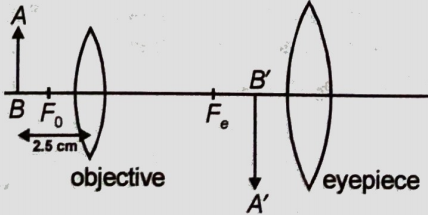The resolving power of an electron microscope is R when accelerating potential is V. If the accelerating potential is increased to 4V, then its new resolving power is:
1. 3 R
2. 2 R
3. 4 R
4. R
एक इलेक्ट्रॉन सूक्ष्मदर्शी की विभेदन क्षमता R है, जब त्वरक विभव V है। यदि त्वरक विभव को 4V तक बढ़ाया जाता है, तब इसकी नई विभेदन क्षमता है:
1. 3 R
2. 2 R
3. 4 R
4. R
Focal lengths of objective and eyepiece of a compound microscope are 2 cm and 6.25 cm respectively. An object AB is placed at a distance of 2.5 cm from the objective which forms the image A'B' as shown in the figure. Maximum magnifying power in this case is

1. 10
2. 20
3. 5
4. 25
एक संयुक्त सूक्ष्मदर्शी के अभिदृश्यक और नेत्रिका की फोकस दूरी क्रमशः 2 cm और 6.25 cm है। एक वस्तु AB को अभिदृश्यक से 2.5 cm की दूरी पर रखा गया है जो आकृति में दिखाए गए अनुसार प्रतिबिम्ब A'B' पर बनाता है। इस स्थिति में अधिकतम आवर्धन क्षमता है:

1. 10
2. 20
3. 5
4. 25
An object is at a distance of 30 cm in front of a concave mirror of focal length 10 cm. The image of the object will be
(1) Smaller in size
(2) Inverted
(3) Between the focus and centre of curvature
(4) All of these
एक वस्तु, 10 सेमी फोकस दूरी के अवतल दर्पण के सामने 30 सेमी की दूरी पर है। वस्तु का प्रतिबिम्ब होगा:
(1) आकार में छोटा
(2) उल्टा
(3) वक्रता केंद्र और फोकस के बीच
(4) ये सभी
What should be the maximum angle of acceptance at the air core interface of an optical fiber,
if \(n_1\) and \(n_2\) are the refractive indices of the core and the cladding respectively?
1.
2.
3.
4.
एक प्रकाशिक तंतु के वायु-क्रोडित अंतरापृष्ठ पर स्वीकृति का अधिकतम कोण कितना होना चाहिए, यदि \(n_1\) और \(n_2\) क्रमशः क्रोड और आच्छद के अपवर्तनांक हैं?
1.
2.
3.
4.
A ray of light traveling in a transparent medium of refractive index falls, on a surface separating the medium from the air at an angle of incidence of 45.For which of the following value of the ray can undergo total internal reflection?
(a) (b)
(c) (d)
अपवर्तनांक के एक पारदर्शी माध्यम में गमन करने वाली प्रकाश की किरण 45के आपतन कोण पर वायु से माध्यम को अलग करने वाली सतह पर आपतित होती है। निम्नलिखित में से के किस मान के लिए किरण पूर्ण आतंरिक परावर्तन से गुजर सकती है?
(a) (b)
(c) (d)
A double convex lens has a focal length of 25 cm. The radius of curvature of one of the surfaces is double of the other. Find the radii if the refractive index of the material of the lens is 1.5.
1. 100 cm, 50 cm
2. 25 cm, 50 cm
3. 18.75 cm, 37.5 cm
4. 50 cm, 100 cm
एक द्विउत्तल लेंस की फोकस दूरी 25 cm है। पृष्ठों में से एक की वक्रता त्रिज्या दूसरे से दोगुनी है। यदि लेंस के पदार्थ का अपवर्तनांक 1.5 है, तब त्रिज्याएँ ज्ञात कीजिए।
1. 100 cm, 50 cm
2. 25 cm, 50 cm
3. 18.75 cm, 37.5 cm
4. 50 cm, 100 cm
A biconvex lens has power P. It is cut into two symmetrical halves by a plane containing the principal axis. The power of one part will be :
1. 0
2.
3.
4. P
एक उभयोत्तल लेंस की क्षमता P है। इसे दो सममित भागों में मुख्य अक्ष वाले समतल द्वारा काटा जाता है। एक भाग की क्षमता कितनी होगी?
1. 0
2.
3.
4. P
A beam of light consisting of red, green, and blue colors is incident on a right-angled prism. The refractive index of the material of the prism for the red, green, and blue wavelengths is 1.39, 1.44, and 1.47 respectively.

The prism will :
1. separate the blue color part from the red and green color
2. separate all the three colors from one another
3. Not separate the three colors at all
4. Separate the red color part from the green and blue colors
लाल, हरे और नीले रंगों से युक्त प्रकाश की किरण समकोण प्रिज्म पर आपतित होती है। लाल, हरे और नीले तरंगदैर्ध्य के लिए प्रिज्म के पदार्थ का अपवर्तनांक क्रमशः 1.39, 1.44 और 1.47 है।

प्रिज्म करेगा:
1. लाल और हरे रंग से नीले रंग के भाग को पृथक
2. तीनों रंगों को एक-दूसरे से पृथक
3. किसी भी स्थिति में तीन रंगों को पृथक नही
4. हरे और नीले रंगों से लाल रंग के भाग को पृथक
A thin prism having refracting angle 100 is made of glass of refractive index 1.42. This prism is combined with another thin prism of a glass of refractive index 1.7. This combination produces dispersion without deviation. The refracting angle of the second prism should be:-
1.
2.
3.
4.
100 अपवर्तक कोण के एक पतले प्रिज्म को 1.42 अपवर्तनांक के काँच से बनाया गया है। इस प्रिज्म को 1.7 अपवर्तनांक के काँच के दूसरे पतले प्रिज्म के साथ जोड़ा जाता है। यह संयोजन विचलन के बिना प्रकीर्णन करता है। दूसरे प्रिज्म का अपवर्तन कोण कितना होना चाहिए?
1.
2.
3.
4.
Assume that light of wavelength 7000 Angstrom is coming from a star. The limit of resolution (in radian) of a telescope whose objective has a diameter of 244 cm, will be
1.
2.
3.
4.
मान लीजिए कि एक तारे से 7000 एंग्स्ट्रॉम तरंगदैर्ध्य का प्रकाश आ रहा है। उस दूरदर्शी की विभेदन सीमा (रेडियन में) कितनी होगी, जिसके अभिदृश्यक का व्यास 244 cm है?
1.
2.
3.
4.






